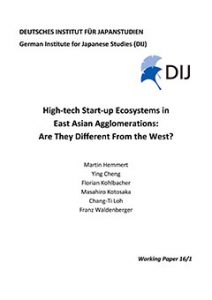
Download
High-tech Start-up Ecosystems in East Asian Agglomerations: Are They Different From the West?
Einzelheiten
2016, Deutsches Institut für Japanstudien, Tokyo, 32 p.Autoren
Kohlbacher, Florian
Cheng, Ying
Kotosaka, Masahiro
Loh, Chang-Ti
Waldenberger, Franz
High-tech Start-up Ecosystems in East Asian Agglomerations: Are They Different From the West?

Start-up ecosystems within regional agglomerations have been intensively studied in Western countries, but much less in East Asia. Therefore, little is known about the specific features of East Asian start-up ecosystems. We study the high-tech start-up ecosystems within four leading East Asian agglomerations: Tokyo, Seoul, Suzhou and Chongqing. Our case studies of these start-up ecosystems reveal that they differ in various important aspects from their Western counterparts. They are located within very large urban agglomerations. Consequently, start-ups firms are co-located with many leading domestic and international firms, and research institutions. However, the networks with these partners tend to be relatively weak and segregated. Government support is strong and results in broad financial assistance for start-ups. We also find differences in the growth and internationalization across the four East Asian start-up ecosystems which can be related to features of the national economies they are located in. Overall, our findings suggest that studies of start-up ecosystems need to consider their regional institutional and cultural context, as there are strong differences between Western and East Asian countries.
Keywords: start-up ecosystem, agglomeration, network, high-tech industry, East Asia